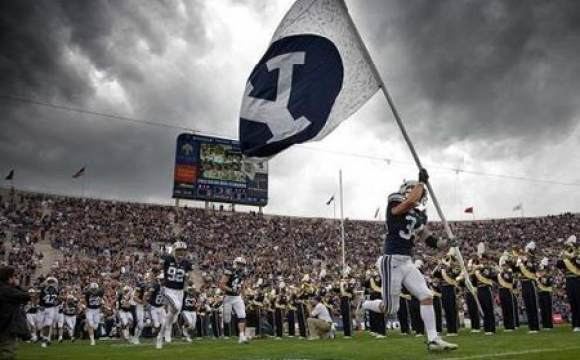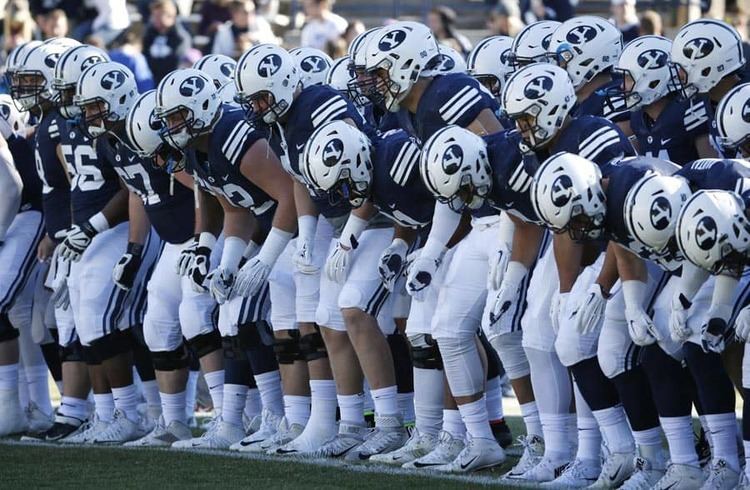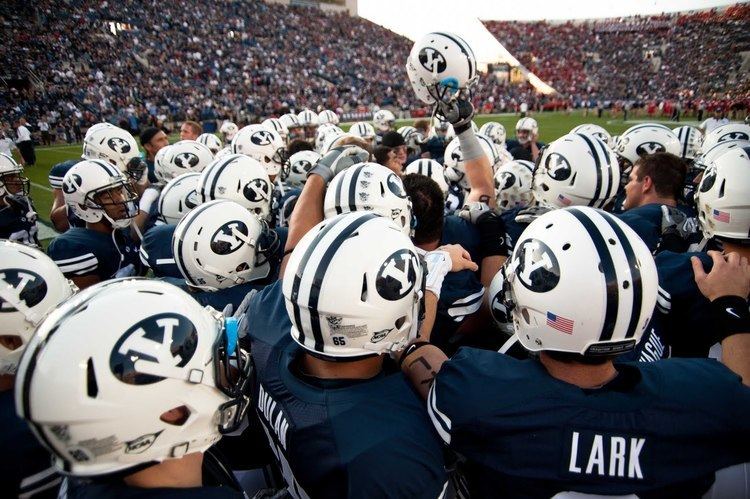First season 1922 Seating capacity 63,470 | Field surface Natural grass Division Division I (NCAA) League Division I (NCAA) | |
 | ||
Rivals | ||
Byu cougars football pump up 2016 17 who we are
The BYU Cougars football team is the college football program representing Brigham Young University (BYU), a private university owned by The Church of Jesus Christ of Latter-day Saints (LDS Church) and located in Provo, Utah, United States. The Cougars began collegiate football competition in 1922, and have won 23 conference titles and 1 national title in 1984. The team has competed in several different athletic conferences during its history, but since July 1, 2011, it has competed as an Independent. The team plays home games at the 63,470-seat LaVell Edwards Stadium, which is named after legendary head coach LaVell Edwards.
Contents
- Byu cougars football pump up 2016 17 who we are
- The early years
- LaVell Edwards era 19722000
- 2001present
- Record book
- Awards
- Uniforms
- Alumni
- Rivalries
- Additional Information
- References
The early years

BYU traces its football roots back to the late 19th century. Benjamin Cluff became the third principal of Brigham Young Academy (the precursor to BYU) in 1892 (the school was converted into a university in 1903) and was influenced by his collegiate studies at the University of Michigan to bring athletic competition to Brigham Young. The first BYU football team in 1896 played the University of Utah (winning 12–4), the Elks, the Crescents, the YMCA of Salt Lake City, the Wheel Club of Denver, and Westminster College; and it ultimately won the championship. In its second year of competition, the BYA football team won the championship too, but as a result of an accidental football-related death in Utah in 1900, football was banned from all LDS Church schools until 1919.

After a twenty-year ban on football, the sport was brought back to BYU on an intramural basis in 1919, and intercollegiate games were resumed in 1920 under coach Alvin Twitchell. BYU was admitted to the Rocky Mountain Conference in 1921 and had its first winning year in 1929 under the helm of coach G. Ott Romney, who BYU recruited from Montana State University the year before. Romney and his successor Eddie Kimball ushered in a new era in Cougar football in which the team went 65–51–12 between 1928–1942. In 1932, the Cougars posted an 8–1 record and outscored their opponents 188–50, which remains one of the school's finest seasons on record. The university did not field a team from 1943–1945 due to World War II, and in 1949 suffered its only winless season, going 0–11.

The team began to rebuild in the mid-1950s, recruiting University of Rhode Island head coach Hal Kopp to lead the Cougars, whom achieved back-to-back winning seasons in 1957 and 1958, led by southpaw quarterback Jared Stephens and nose tackle Gavin Anae. In 1961, Eldon "The Phantom" Fortie became the school's first All-American, and in 1962, BYU moved to the Western Athletic Conference. In 1964, Cougar Stadium was built, which included a capacity of 30,000, and in 1965, head coach Tommy Hudspeth led the Cougars to their first conference championship with a record of 6–4.
LaVell Edwards era (1972–2000)

In 1972, assistant coach LaVell Edwards was promoted to head coach replacing Kopp. Edwards and his staff installed a drop-back passing game considered to be an early implementation of the West Coast offense, resulting in Cougar Pete Van Valkenburg as the nation's leading rusher for that year. The following year the Cougars struggled to a 5–6 finish, but this would be Edwards' only losing season during his run as BYU coach over the next three decades. In fact, the Cougars won the conference championship every year except one from 1974–1985, including the national championship in 1984. However, the Cougars lost their first four bowl games. Their first post-season win came in the 1980 Holiday Bowl, which has become known as the "Miracle Bowl" since BYU was trailing SMU 45–25 with four minutes left in the game and then came back to win. BYU would win its 1981, 1983 and 1984 bowl games as well; and it earned the nickname "Quarterback U" for consistently producing All-American quarterbacks, which included Gifford Nielsen, Marc Wilson, Jim McMahon and Steve Young. During this period, Young finished second for the Heisman Trophy in 1983 and McMahon finished third for the trophy in 1981.

In 1984, BYU reached the pinnacle of college football when it won the national championship. The undefeated Cougars (12–0–0) opened the season with a 20–14 victory over Pitt, ranked No. 3 in the nation at the time and finished with a victory over the Michigan Wolverines (6–5–0). BYU defeated Michigan 24–17 in the Holiday Bowl, marking the only time a national champion played in a bowl game before New Year's Day, and the last time the national championship was won by a team from a non-power 5 conference. Coupled with the 11 consecutive wins to close out the 1983 season, BYU concluded the 1984 championship on a 24-game winning streak. Some college football pundits argued that BYU had not played a legitimate schedule and thus should not be recognized as national champion. Nonetheless, at the end of the season, BYU was crowned as national champion after being a near-unanimous number one in all four NCAA sanctioned polls AP, Coaches, NFF and FWAA.

In 1985, quarterback Robbie Bosco finished third in the Heisman balloting; in 1986, defensive lineman Jason Buck became the first BYU player ever to win the Outland Trophy; and in 1989, offensive lineman Mo Elewonibi also won the Outland Trophy. In 1990, the Cougars achieved their first victory over a top-ranked team when they defeated the #1 Miami Hurricanes early in the season, and the season culminated with quarterback Ty Detmer becoming BYU's first and only Heisman Trophy winner. In 1996, BYU won the first ever WAC Championship Game in Las Vegas and earned a bid to play in the Cotton Bowl against Kansas State of the newly formed Big 12 Conference, making it BYU's first ever New Year's Day bowl game, which they won 19–15. BYU finished ranked No. 5 in both the Coaches and AP polls, and became the first team in NCAA history to win 14 games in a season.
In 1999, BYU left the WAC along with seven other teams to form the Mountain West Conference, with the Cougars winning a share of the inaugural MWC championship. Just prior to the 2000 season, Edwards announced that it would be his final year as the program's head coach, and prior to Edwards' final home game, LDS Church President Gordon B. Hinckley announced that Cougar Stadium would be renamed "LaVell Edwards Stadium". Edwards was carried off the field following the season closer against the Utes.
2001–present
Chicago Bears offensive coordinator Gary Crowton was hired to replace Edwards. His first season was successful, earning a 12–2 record and running back Luke Staley earning the Doak Walker Award, but the Cougars posted losing records the following three seasons (including only nine conference wins) and received negative publicity for infractions of the university's honor code. He was forced to resign on December 1, 2004.
On September 1, 2010, BYU announced it would begin competition as a football independent starting in the 2011 season, primarily due to years of frustration with the lack of TV coverage in the Mountain West Conference and the University of Utah's departure for the Pac-12 Conference. BYU later entered into an 8-year contract with ESPN in which 11 games would be broadcast on one of the ESPN networks and BYU would retain the rights to utilize its on-campus broadcasting facilities and nationally syndicated station. The Cougars were reportedly considered for invitations by the Big XII Conference and former Big East Conference for all sports during this period, but neither opted to add BYU. In February 2011, CFL's Most Outstanding Canadian Award Ben Cahoon joined the coaching staff as the wide receivers coach.
In 2011, BYU changed quarterbacks mid-season from sophomore Jake Heaps to junior Riley Nelson, and in 2012 three different quarterbacks were utilized at different points in the season. During the 2012 offseason, graduated defensive end Ziggy Ansah was drafted as the #5 overall pick of the 2013 NFL Draft, tied for the highest draft BYU alumnus with Jim McMahon '82. For the 2013 BYU football season, the Cougars were slated to compete against four pre-season-ranked teams.
In January 2015, the Atlantic Coast Conference (ACC), which had previously announced that from 2017 forward all members had to play at least one non-conference game each season against a "Power 5" team (i.e., a school in the ACC, Big Ten, Big 12, Pac-12, or SEC, plus Notre Dame, an FBS independent but otherwise an ACC member), announced that games against BYU would not count toward the "Power 5" requirement, a stipulation also held by the SEC. Weeks later, both leagues reversed course and opted to count games against BYU and the other remaining FBS independent at that time, Army, toward meeting the P5 provision. In the case of the SEC, this change in policy was driven more by the trend of "Power 5" leagues requiring nine conference games. At the time of the report, the Big Ten, Big 12, and Pac-12 either had nine-game conference schedules or were introducing them in the near future. The ACC has an eight-game schedule, but also has a scheduling alliance with Notre Dame that has five ACC members playing the Fighting Irish each season. Additionally, three SEC teams had a total of five games scheduled with BYU from 2015 to 2020. In July 2015, the Big Ten announced that games against BYU would count toward the conference's "Power 5" scheduling requirement that takes effect in 2016. In late 2015, the Big XII Conference added a Power Five non-conference scheduling requirement and stated that BYU would not count toward filling that mandate.
On December 4, 2015 Bronco Mendenhall accepted the Head Coaching position with Virginia in the Atlantic Coast Conference (ACC). BYU spent more than a week courting Naval Academy Head Coach Ken Niumatalolo to take over the Cougars program. After several days, which included a visit to Provo and public remarks about considering the job, Niumatalolo ultimately declined BYU's offer in order to remain with Navy. With his top choice no longer available, Athletics Director Tom Holmoe moved on to several other potential candidates and on Dec. 19 introduced Oregon State defensive coordinator and former Cougars fullback Kalani Sitake as BYU's next head coach.
Record book
BYU has had 18 final season rankings in the Top 25. The team has made 35 Bowl appearances with a record of 14–20–1. They have played in the Holiday Bowl (4–6–1), the Cotton Bowl Classic (1–0), the Las Vegas Bowl (3–2), the Copper Bowl (1–0), the Tangerine/Citrus Bowl (0–2), the Freedom Bowl (1–1), the Liberty Bowl (0–2), the Aloha Bowl (0–1), the Fiesta Bowl (0–1), the Motor City Bowl (0–1), the All-American Bowl (0–1), the New Mexico Bowl (1–0), the Armed Forces Bowl (1–0), the Poinsettia Bowl (2–0), Fight Hunger Bowl (0–1), and the Miami Beach Bowl (0–1).
Awards
Team awards for the BYU Cougars include 23 conference titles and one national championship in 1984. For player awards, BYU has produced 51 All-Americans (13 Consensus All-Americans), and one Heisman Trophy winner (Ty Detmer in 1990). Other BYU players finishing in the top ten in Heisman voting include Gary Sheide (8th in 1974), Gifford Nielsen (6th in 1976), Marc Wilson (3rd in 1979), Jim McMahon (5th in 1980, 3rd in 1981), Steve Young (2nd in 1983), Robbie Bosco (3rd in 1984 and 1985), and Ty Detmer (9th in 1989, Winner in 1990, 3rd in 1991). Detmer also won the Maxwell Award (best football player) in 1990.
Four BYU players have won the Davey O'Brien Award (best quarterback)—Jim McMahon, Steve Young, and Ty Detmer twice—more than any other school; and seven players have won the Sammy Baugh Trophy (best passer): Steve Sarkisian (1996), Gary Sheide (1974), Marc Wilson (1979), Jim McMahon (1981), Steve Young (1983), Robbie Bosco (1984), and Ty Detmer (1991). Luke Staley won the Doak Walker Award (best running back) and Jim Brown Trophy (best running back) in 2001. Two players earned the Outland Trophy (best interior lineman): Jason Buck (1986) and Moe Elewonibi (1989).
For coaching, LaVell Edwards received the Bobby Dodd Coach of the Year Award in 1979, the AFCA (Kodak) Coach of the Year Award in 1984, and the Amos Alonzo Stagg Award (career achievement) in 2003.
Six player have been inducted into the College Football Hall of Fame (Gifford Nielsen in 1994, Marc Wilson in 1996, Jim McMahon in 1999, Steve Young in 2001, Gordon Hudson in 2009, and Ty Detmer in 2011) and LaVell Edwards was inducted as a coach in 2004.
Uniforms
From the 1970s to 1999—a period coinciding with some of the school's best and most prominent football seasons—BYU school colors were royal blue and white. The football team generally wore royal blue jerseys and white pants at home, and white jerseys and royal blue pants on the road.
In 1999, Coach Edwards' penultimate year, the school colors switched to dark blue, white, and tan, and the football helmets switched from white to dark blue. The block 'Y' remained on the sides of the helmet but received a new, more current treatment. The home uniforms consisted of dark blue jerseys with white "bib" and dark blue pants, and the away uniforms consisted of white jerseys with white pants. These new uniforms were disliked by both the conservative fans in Provo and the NCAA, who required the team to remove the white bib on the front of the blue home jersey in 2000 (NCAA rules require that a team's jersey have a single dominant color). The home jersey thereafter was modified with blue replacing the white on the bib area.
These uniforms lasted until 2004, when a uniform new style incorporating New York Jets-style shoulder stripes was introduced (the helmets remained the same). The new uniforms were worn in a "mix-and-match" strategy—e.g., the home blue jerseys were worn with either blue or white pants and the white away jerseys were worn with either blue or white pants. This uniform incarnation lasted for only one season.
Ultimately, the traditional design with the white helmet and former logo was re-introduced for the 2005 season. While the uniforms were also changed to be similar to the 1980s uniforms, the darker blue remained instead of the former royal blue, but all tan highlights were eliminated. This change was done at the insistence of new head coach Bronco Mendenhall, who wanted to return the team to the successful traditions of the 1980s. Normally, it takes a minimum of 1–2 years to create, design and approve a uniform change. When Nike, the team's uniform supplier, said that they could not possibly make the change in just five months, former head coach and BYU legend LaVell Edwards made a call to Nike and asked them to help the new Cougar coach. Edwards had worked with Nike on several occasions since his retirement, and with the legendary coach's weight behind the request, BYU was able to take the field in 2005 in new, traditional uniforms. One slight change in the uniform came in the 2007 season, when a small traditional 'Y' logo was added to the bottom of the collar. In 2009 BYU used a "throwback" jersey paying tribute to the 25-year anniversary of the 1984 National Championship. They were the same design as the current jerseys but royal blue instead of navy blue. They were introduced against rival University of Utah and again in the Las Vegas Bowl against Oregon St. BYU also introduced new "black-out" jerseys in the 2012 season, debuting at home, also against Oregon St.
Alumni
As of 2008, 146 BYU Cougars football players have gone on to play professional football. Team alumni have competed in 48 NFL Super Bowls, including Super Bowl MVP Steve Young and two-time Super Bowl winner Jim McMahon.
Rivalries
BYU's football program has two historic rivalries: one with the Utah Utes in a game referred to as "The Holy War", and another with the Utah State Aggies in "The Battle for the Old Wagon Wheel". An emerging rivalry resulting from recent and anticipated future consecutive competition is Boise State, who BYU plays every year from now until 2023.
Additional Information
BYU and Notre Dame announced an additional four games to be played between 2014–2020 in both Provo and South Bend. Notre Dame later announced, though, that due to its scheduling alliance with the ACC it no longer planned to honor the remainder of the agreement with BYU. The Irish played two games of the deal (both at home) but exercised the escape clause in the contract for the other four, including two scheduled for Provo.
